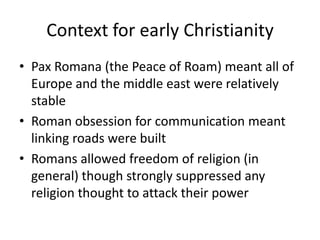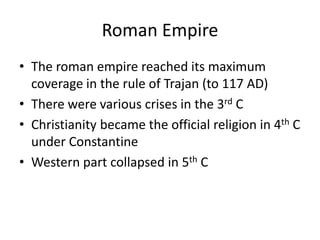Christianity after christ
- 2. Historical Sources âĒ We have quite detailed historical sources for the early years of Christianity after ChristâĶ âĒ The Acts of the Apostles was a second book written by the Greek physician Luke âĒ Many of the epistles (letters) refer to incidents, heresies, issues, people and churches âĒ As Christianity became a growing force other writers and commentators started to make reference to itâĶ not always in a complimentary way!
- 3. Stages in the spread of Christianity
- 4. Impact of Paul of Tarsus
- 6. Context for early Christianity âĒ Pax Romana (the Peace of Roam) meant all of Europe and the middle east were relatively stable âĒ Roman obsession for communication meant linking roads were built âĒ Romans allowed freedom of religion (in general) though strongly suppressed any religion thought to attack their power
- 7. Religion âĒ Romans: polytheistâĶ the official religion âĒ Greek: wide spread due to earlier Greek empireâĶ polytheist âĒ Romans blended or identified Greek gods as Roman gods âĒ Other cults and local religions were plentiful âĒ Practices included idol worship, talismans, witchcraft, necromancy, temple prosititution, sacrifice, superstition
- 8. Opposition âĒ Jewish synagogues and leaders were hostile to what was seen as a false messiah cult âĒ Local religions were hostile to the idea of losing revenue and adherents âĒ Some people saw Christianity as a interesting new way for them to seek power (or extort money) and claimed to be Christian exorcists, healers or teachers âĒ All of this can be read about in Acts 19 âĒ Romans, while initially without interest, became concerned as numbers grew, despite the emphasis in Christianity on peace and personal holiness âĒ Nero persecuted Christians in Rome after the great fire of 64 CE
- 9. Roman Empire âĒ The roman empire reached its maximum coverage in the rule of Trajan (to 117 AD) âĒ There were various crises in the 3rd C âĒ Christianity became the official religion in 4th C under Constantine âĒ Western part collapsed in 5th C








